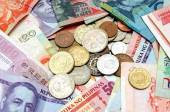Dollar Falls Against Yen as U.S. Reports Show Slower Growth
Nov. 24 (Bloomberg) -- The dollar weakened to the lowest level versus the yen in a month after reports showed the U.S. economy expanded at a slower pace in the third quarter than initially estimated and home prices dropped from a year earlier.
Japan’s currency gained against all 16 major counterparts and is set to post its first monthly increase versus the greenback since September. The Federal Reserve is scheduled to release at 2 p.m. today the minutes from the Nov. 4 policy meeting where it lowered the amount of agency debt it plans to purchase by March.
“Any negative data could cause people to shirk the risk- seeking trades,” said Brian Kim, a currency strategist at UBS AG in Stamford, Connecticut. “The minutes are going to be one of the larger focuses.”
The dollar fell 0.5 percent to 88.57 yen at 12 p.m. in New York from 88.97 yesterday, after touching 88.36, the lowest level since Oct. 9. The euro declined 0.2 percent to $1.4938 and slumped 0.6 percent to 132.32 yen.
The euro swung to a loss versus the dollar after a U.S. consumer confidence report showed an unexpected increase in November. The New York-based Conference Board’s index advanced to 49.5 from 48.7 in October and beat economist predictions for a decline to 47.3.
The pound fell against the euro on speculation the U.K. central bank will extend its asset purchase program after Bank of England Governor Mervyn King said the U.K. economy faces “profound challenges.” Sterling fell as much as 0.5 percent to 90.57 pence per euro from 90.10 pence yesterday.
Mexican Peso
Japan’s yen gained against higher-yielding counterparts including the Mexican peso and South African rand as share prices globally slumped. The Standard & Poor’s 500 index fell 0.3 percent and the MSCI World Index of shares slid 0.6 percent. Benchmark rates of 4.5 percent in Mexico and 7 percent in South Africa exceed Japan’s 0.1 percent overnight lending rate.
The yen was the only major currency to rise against Mexico’s peso today after Pacific Investment Management Co. said the Latin American currency is one of the cheapest in emerging markets and may rise as much as 20 percent over the next year. Fitch Ratings cut Mexico’s foreign debt rating yesterday by one level to BBB.
The peso advanced 0.5 percent to 7.4749 per Brazilian real and 1.2 percent to 9.3802 versus the New Zealand dollar. It declined 0.3 percent to 6.846 yen.
“The peso is one of the cheapest currencies in emerging markets,” said Guillermo Osses, who helps oversee about $50 billion in emerging-market assets at Pimco, manager of the world’s biggest bond fund. “External accounts will improve.”
Osses predicts the peso will advance between 10 percent to 20 percent in one to two years as the U.S. economy recovers. He also said Pimco may add to its holdings of Mexican assets.
U.S. Growth
The U.S. government’s revised figures for third-quarter gross domestic product showed the world’s largest economy expanded at a 2.8 percent annual rate, slower than the Commerce Department’s 3.5 percent estimate last month.
“In the current environment a weak U.S. gross domestic product number weighs on sentiment,” said Antje Praefcke, a currency analyst at Commerzbank AG in Frankfurt. “Traders are a little more sensitive to sentiment changes because they want to get out of positions ahead of the long U.S. weekend.”
The Fed said on Nov. 4 that it plans to reduce its purchases of agency debt to $175 billion from the previous $200 billion. Fed Bank of St. Louis President James Bullard said on Nov. 22 that the central bank should maintain the purchase program to give policy makers “the option to react” to future events beyond March.
“It’s going to be interesting to see if there are more ‘Bullardish’ comments” in the Fed’s minutes, said Kim of UBS.
Fed on Hold
The U.S. central bank will probably have to keep rates close to zero until 2011, encouraging investors to send funds abroad to earn higher returns, according to JPMorgan Chase & Co. The dollar will weaken to $1.62 per euro in the second quarter next year, currency strategists led by John Normand in London wrote in the investment bank’s Global FX Outlook 2010.
“Fed policy is a key driver because it determines the dollar’s attractiveness as a funding currency,” Normand said in an interview. Normand said in an interview. “The dollar’s decline is more than a carry trade. Global investors’ preference for non-U.S. equities, rising merger and acquisition outflows from the U.S. and central-bank reserve diversification are compounding the dollar’s decline.”
In carry trades, investors borrow in one currency to invest in others that offer higher yields. Increasing price swings in foreign-exchange markets increase the risk of losses on such strategies by boosting the odds that the funding currency strengthens and makes it more expensive to repay the loan.
The S&P/Case-Shiller home-price index increased 0.27 percent from the prior month, after a 1.13 percent rise in August, the group said. The gauge fell 9.36 percent from September 2008, more than forecast, yet the smallest year-over- year decline since the end of 2007.






Automated Forex Trading: eaglefx login Is An Automated Forex Investing Software. It Is An Algorithmic Trading Software That Provides Automated Forex Trading Signals.
ReplyDelete